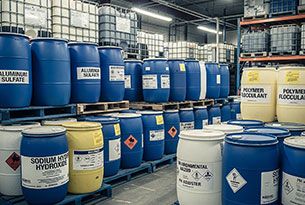Oxidizing agents, leveraging high redox potentials, catalyze electron transfer reactions to degrade recalcitrant wastewater contaminants, enabling Ecologix Environmental Systems to achieve regulatory-compliant pollutant removal.
That is a fancy way of saying we add certain types of chemicals to dirty water to help us make it clean.
Here is a condensed snapshot of our top 10 oxidizing agents along with what we think about when we are specifying a solution to the client's challenge. Which oxidizers? Why? Pros and cons. How do we best apply it and where? What is the estimated volume needed to achieve the goal? Will the OpEx costs make sense?
Top 10 Most Common Oxidizing Agents
- Chlorine (Cl₂)
- Use: Kills germs and bacteria to disinfect water; removes odorous compounds like hydrogen sulfide (H2S)
- How: Primarily injected as a gas into wastewater via diffusers or injectors for rapid mixing; residual chlorine maintains disinfection during downstream retention time.
- Benefits: Affordable, widely available, and highly effective for disinfection.
- Cost: Low-cost, making it a go-to for many treatment facilities.
- Challenges: Forms harmful byproducts like trihalomethanes (CHX3), requiring extra treatment; loses effectiveness outside pH 6.5-7.5; hazardous to handle.
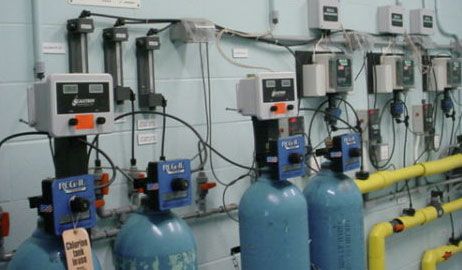
Chlorine gas injection system - Calcium Hypochlorite (Ca(OCl)₂)
- Use: Disinfects water and controls germ growth; reduces odorous compounds like hydrogen sulfide (H2S)
- How: Dissolved from solid tablets or granules and dosed into wastewater, often for smaller systems or where gas handling is impractical; provides residual disinfection downstream.
- Benefits: Easy to store as a solid, effective for disinfection, suitable for remote or small-scale facilities.
- Cost: Mid-range, cost-effective for smaller systems.
- Challenges: Produces byproducts like trihalomethanes (CHX3), pH-sensitive; handling risks for solid form.
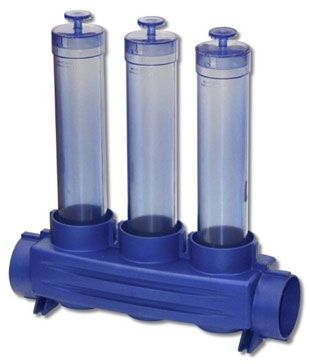
Chlorine tablet feeder system - Sodium Hypochlorite (NaOCl)
- Use: Disinfects water and controls odorous compounds like hydrogen sulfide (H2S).
- How: Dosed as a liquid using automated systems for precise application; ensures residual disinfection during retention time.
- Benefits: Easy to handle as a liquid, effective for microbial control, widely used in large systems.
- Cost: Low-cost, comparable to chlorine gas.
- Challenges: Produces byproducts like trihalomethanes (CHX3), pH-dependent efficacy; handling risks.
- Ozone (O₃)
- Use: Breaks down tough pollutants like oils or dyes, disinfects water, and reduces Chemical Oxygen Demand (COD) by oxidizing organic compounds.
- How: Generated on-site and injected as a gas into wastewater.
- Benefits: Powerful, minimizes byproduct formation, and eco-friendly.
- Cost: High due to expensive on-site generation equipment.
- Challenges: Energy-intensive; can corrode pipes and equipment; requires safety protocols for handling.
- Hydrogen Peroxide (H₂O₂)
- Use: Breaks down pollutants like grease or chemicals; aids disinfection.
- How: Added as a liquid in precise amounts via automated systems.
- Benefits: Decomposes into harmless water and oxygen, eco-friendly.
- Cost: Mid-range, balancing cost and safety.
- Challenges: Degrades quickly, complicating storage; sensitive to pH levels.
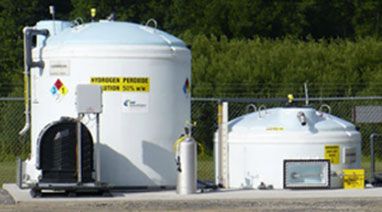
Hydrogen peroxide injection system - Potassium Permanganate (KMnO₄)
- Use: Breaks down odorous compounds like hydrogen sulfide (H2S); removes pollutants.
- How: Added as a solid or liquid in controlled doses.
- Benefits: Effective for specific pollutants like hydrogen sulfide (H2S).
- Cost: Moderate, widely available.
- Challenges: Less versatile; may require additional treatment for residuals.
- Chlorine Dioxide (ClO₂)
- Use: Disinfects water with fewer byproducts than chlorine.
- How: Generated on-site and injected for immediate use.
- Benefits: Highly effective with fewer byproducts than chlorine.
- Cost: High due to on-site generation requirements.
- Challenges: Hazardous to handle; requires specialized systems; costly equipment.
- Oxygen (O₂)
- Use: Supports microbes that eat organic waste; oxidizes pollutants.
- How: Bubbled through wastewater in aeration tanks.
- Benefits: Eco-friendly, supports biological treatment processes.
- Cost: Low to moderate, depending on aeration systems.
- Challenges: Limited to specific applications; energy-intensive aeration; less effective for complex pollutants.
- Peracetic Acid (CH3CO3H)
- Use: Kills a wide range of germs and pathogens in water.
- How: Dosed as a liquid with precise metering systems.
- Benefits: Broad-spectrum antimicrobial, effective at low concentrations.
- Cost: Moderate to high, depending on application scale.
- Challenges: Corrodes equipment; sensitive to pH; handling precautions needed.
- Sodium Peroxide (Na₂O₂)
- Use: Oxidizes organic pollutants and aids in pH adjustment; supports disinfection.
- How: Added as a solid or dissolved solution, often in industrial wastewater treatment.
- Benefits: Effective for oxidation and alkalinity control, stable for storage.
- Cost: Moderate, widely available for industrial applications.
- Challenges: Can increase pH excessively, requiring neutralization; less common for disinfection compared to chlorine-based agents.
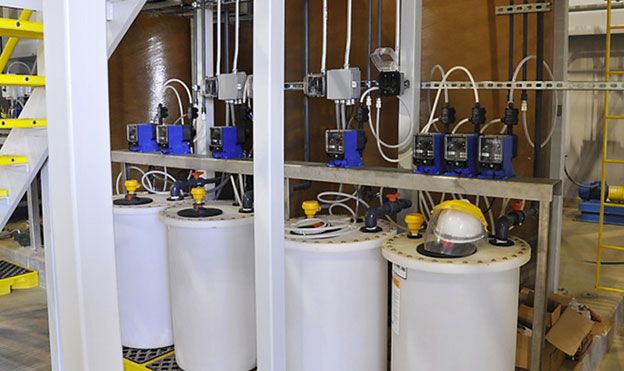
Chemical dosing system
Ready to Optimize Your Water Treatment?
Connect with Ecologix Systems today to discuss your specific needs and discover how our advanced solutions can enhance your operations.
Contact Our Experts Now